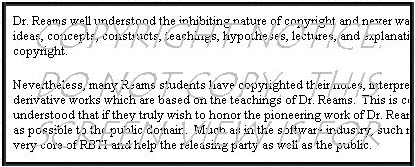A few words on copyright...
The Reams family stands united in their commitment to honor Carey Reams' final instruction: I wish to leave the Reams Biological Theory of Ionization to the world.
Carey Reams once said, "I feel like I'm only in first grade as far as the possibilities of RBTI." The Reams family wishes for the world's researchers to take the RBTI as far as it can go toward solving the many agricultural and human health problems we all face.
Reams well understood the inhibiting nature of copyright and never wavered from start to finish that his original theories, ideas, concepts, constructs, teachings, hypotheses, lectures, and explanations should not be restricted in any way by copyright.
Nevertheless, many Reams students have copyrighted their notes, interpretations, books, class manuals, and other derivative works which are based on the teachings of Carey Reams. This is certainly their legal right, but it should always be understood that if they truly wish to honor the pioneering work of Reams they will release as much copyrighted material as possible to the public domain. Much as in the software industry, such release to the public domain will strengthen the very core of RBTI and help the releasing author as well as the public.
Something that should not go unsaid is that courts routinely rule that while fully protecting the right of a copyright holder to harvest the fruit of their labor, copyright law does not afford protection to anyone wishing to use it to shield their work from criticism or ridicule. Specifically;
"Under the fair use doctrine of the U.S. copyright statute, it is permissible to use limited portions of a work including quotes, for purposes such as commentary, criticism, news reporting, and scholarly reports."
http://www.publaw.com/cfaqs.html
Finally, in this website you may observe reproductions with associated critique of apparently copyrighted work, charts, documents, notes, tables, etc. Such critique is solely for the purpose of furthering RBTI and is never intended to infringe. Such reproductions will be overlaid with a watermark indicating they are for critique purposes only. As in the below sample, the watermark will be so placed as to negate unauthorized copying or distribution. An alternate method is to watermark a document "Not for public release."
Carey Reams once said, "I feel like I'm only in first grade as far as the possibilities of RBTI." The Reams family wishes for the world's researchers to take the RBTI as far as it can go toward solving the many agricultural and human health problems we all face.
Reams well understood the inhibiting nature of copyright and never wavered from start to finish that his original theories, ideas, concepts, constructs, teachings, hypotheses, lectures, and explanations should not be restricted in any way by copyright.
Nevertheless, many Reams students have copyrighted their notes, interpretations, books, class manuals, and other derivative works which are based on the teachings of Carey Reams. This is certainly their legal right, but it should always be understood that if they truly wish to honor the pioneering work of Reams they will release as much copyrighted material as possible to the public domain. Much as in the software industry, such release to the public domain will strengthen the very core of RBTI and help the releasing author as well as the public.
Something that should not go unsaid is that courts routinely rule that while fully protecting the right of a copyright holder to harvest the fruit of their labor, copyright law does not afford protection to anyone wishing to use it to shield their work from criticism or ridicule. Specifically;
"Under the fair use doctrine of the U.S. copyright statute, it is permissible to use limited portions of a work including quotes, for purposes such as commentary, criticism, news reporting, and scholarly reports."
http://www.publaw.com/cfaqs.html
Finally, in this website you may observe reproductions with associated critique of apparently copyrighted work, charts, documents, notes, tables, etc. Such critique is solely for the purpose of furthering RBTI and is never intended to infringe. Such reproductions will be overlaid with a watermark indicating they are for critique purposes only. As in the below sample, the watermark will be so placed as to negate unauthorized copying or distribution. An alternate method is to watermark a document "Not for public release."
Please report any unintentional violations you observe in this website so that offending materials can be removed.
